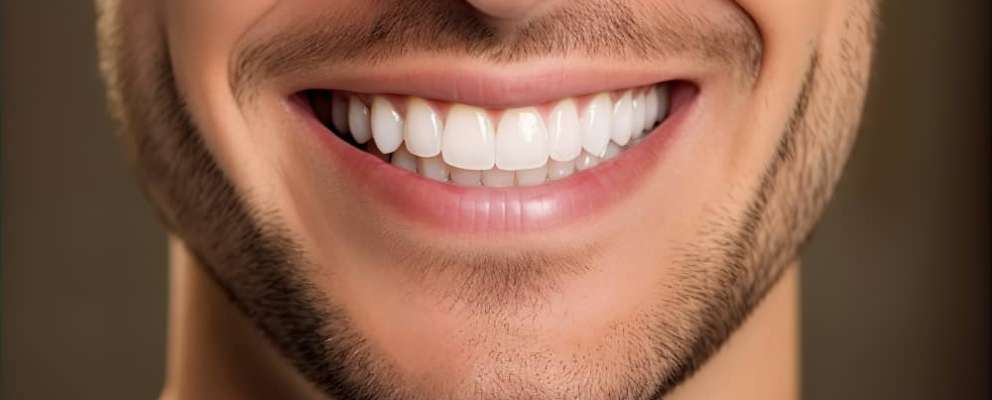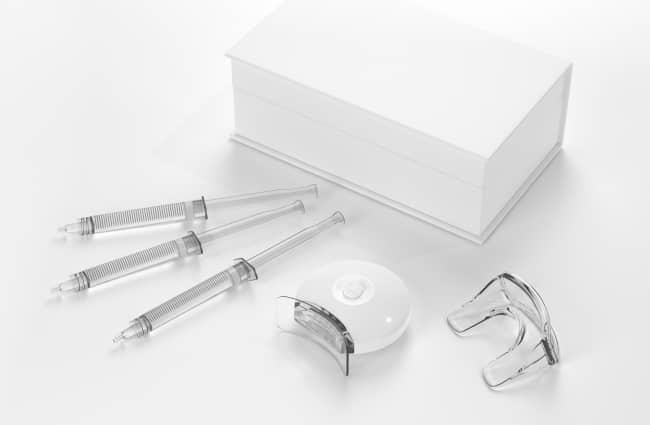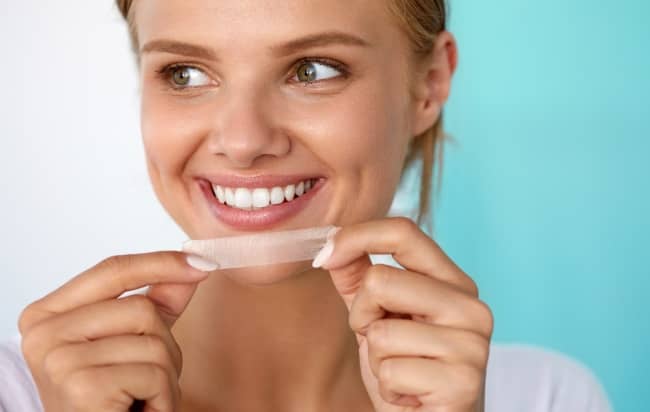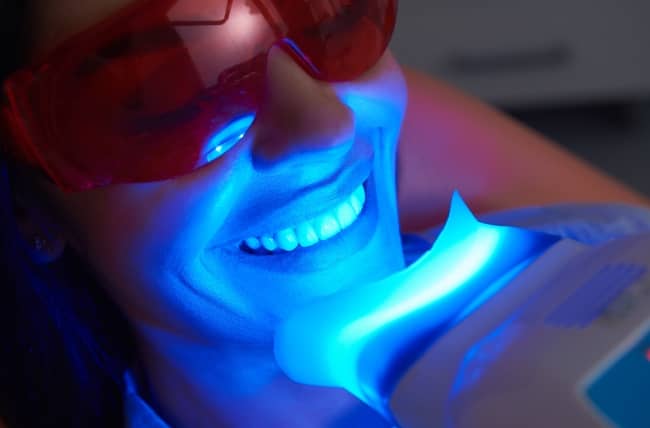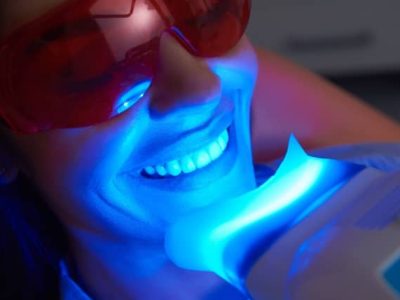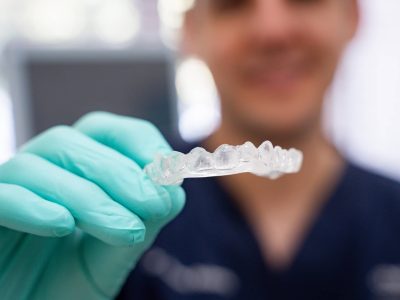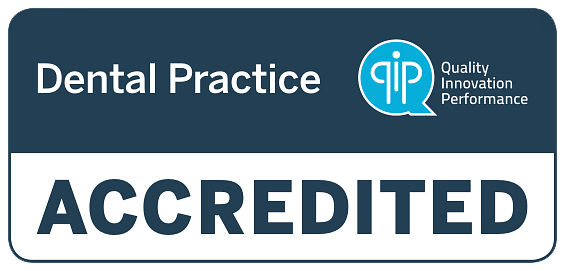Do you brush twice a day, floss every day, and maintain good oral hygiene but still struggle with dull or discoloured teeth?
Even with the best oral hygiene, trauma to the teeth, certain medications, highly pigmented foods, and other factors can cause stained or discoloured teeth.
Teeth whitening is the most popular cosmetic dental treatment. From home whitening kits to DIY teeth whitening remedies to professional teeth whitening, we’ll cover the different options available so you can choose the teeth whitening treatment that is best for you.
We’ll also look at the pros and cons of home teeth whitening versus professional teeth whitening, safety tips for teeth whitening, and tips for whitening sensitive teeth.
1. Over-the-Counter Teeth Whitening Products
Over-the-counter teeth whitening products are a popular way to achieve subtle whitening results.
There are various over-the-counter teeth whitening options, including whitening strips, whitening gels, and whitening toothpaste. These products rely on mild abrasives to help remove surface stains.
Over-the-counter teeth whitening products can be a convenient, affordable way to experience a slightly brighter smile.
While these products can deliver subtle brightening to the teeth they do have limitations. It is also important to be careful not to overuse these products as they can lead to tooth sensitivity.
If you opt for the over-the-counter teeth whitening option, be careful of any teeth sensitivity you might experience. If you notice teeth sensitivity, talk with your dentist.
2. Professional Teeth Whitening at the Dentist’s Office
Professional teeth whitening involves the application of medical-grade whitening gel. This effective gel gets applied to the surface of the teeth and is activated by an LED light.
This process quickly breaks down stains and reveals noticeably whiter teeth. Professional teeth whitening works far faster than over-the-counter teeth whitening products and also produces more dramatic results.
Benefits of professional in-chair whitening include:
- Fastest teeth whitening possible
- Most effective teeth whitening option, especially for deeper or stubborn stains
- Provides dramatic, noticeable results — often in a single visit
- Safest teeth whitening option
- Provides long-lasting results
- Offers completely customised treatment
Your dentist has access to advanced technology and stronger concentrations of whitening agents, allowing you to transform your smile in as little as an hour. Professional teeth whitening can break up deeper stains and provide longer-lasting results than whitening toothpaste or strips.
In-chair teeth whitening completed by a qualified dentist is the safest option for teeth whitening. With knowledge of exactly how to work with bleaching agents and an understanding of sensitivity, your dentist can effectively whiten your teeth while minimising any potential issues.
3. At-Home Teeth Whitening Kits
Along with in-chair whitening, we offer custom-fitted whitening trays at Chelmsford Dental that can be used right from the comfort of your home and on your schedule.
Although this process takes longer, it can still produce drastic whitening results with minimal sensitivity issues.
Benefits of professional at-home teeth whitening kits include:
Convenient — Take-home whitening trays can be used according to your schedule, making it easy to whiten your teeth at home.
Personalised — A take-home teeth whitening kit will be customised to your exact needs by your dentist. The trays will also be manufactured to fit your mouth shape exactly, ensuring the most comfortable treatment possible. Your dentist will work closely with you to help minimise sensitivity while maximising results.
More Affordable — Take-home teeth whitening kits are ideal if you are looking for a more affordable alternative to professional in-chair teeth whitening.
User-Friendly — Take-home whitening kits are simple to use. Generally, you’ll just place the dental-grade whitening gel into the tray and wear it overnight. You’ll be instructed on exactly how much gel to use, how long to wear the trays, and what to do if you experience any sensitivity.
Ideal Maintenance Option —Take-home treatments can be used as a whitening ‘top-up’ now and then.
Fast Results — While take-home whitening trays provide more gradual results than in-chair whitening, users can still expect to see visible results after just a week or two.
4. Natural Teeth Whitening Remedies
Popular natural teeth whitening remedies include the use of ingredients such as baking soda, hydrogen peroxide, apple cider vinegar, lemon juice, or activated charcoal. Some individuals also use oil pulling as a DIY whitening method.
While some of these DIY whitening methods can produce subtle results, many of them do not work at all or can lead to sensitivity issues. Some DIY teeth whitening treatments can even damage your enamel.
Working with your dental professional ensures they can pinpoint the cause of stained teeth and determine the most efficient, safe solution. Always consult with your dentist before trying any natural teeth whitening remedies.
5. Laser Teeth Whitening
Laser teeth whitening involves bleaching gel that is heated up and activated by a laser. Laser teeth whitening can produce dramatic, fast results.
Since the laser can be customised to treat teeth individually rather than all at once, it can be a good option for patients with just a few teeth that want to be whitened.
Though effective, laser teeth whitening may include side effects. The high peroxide concentration may lead to gum irritation, discomfort, or tooth sensitivity. The laser itself can cause harm to your eyesight if used improperly.
If you are considering laser teeth whitening, it is crucial to only see a dentist who is certified and highly experienced in this treatment method. Protective goggles are a must for laser teeth whitening.
6. Teeth Whitening Strips vs. Whitening Trays
Over-the-counter teeth whitening strips and whitening trays are an affordable, convenient way to experience a slightly whiter smile.
While affordable, store-bought teeth whitening strips and trays lack the customisation and professional supervision offered by in-chair whitening or take-home trays from your dentist.
Teeth whitening strips often overlap the gums, exposing the gums to hydrogen peroxide. This can lead to sensitivity issues.
Over-the-counter whitening tray kits feature generic trays that are one-size-fits-all. These trays may not fit the contours of your mouth, leading to discomfort and reduced results.
7. Whitening Toothpaste vs. Regular Toothpaste
As opposed to regular toothpaste, whitening toothpaste features the addition of buffing compounds meant to help polish away stains.
Whitening toothpaste is generally only capable of decreasing surface stains on the teeth. While this can be a great way to achieve subtle whitening results, professional teeth whitening is the most effective option.
Whitening toothpaste can be an ideal complement to professional teeth whitening to help maintain your results. Ask your dentist if you should add a whitening toothpaste to your routine or stick to regular toothpaste.
It may be recommended to stick to regular toothpaste, especially if you experience tooth sensitivity. Using a whitening toothpaste daily may aggravate your sensitivity.
Certain whitening toothpaste can be especially harsh and abrasive, making it important to have your whitening routine supervised by your dentist.
Your dental professional can ensure you aren’t whitening too often and causing unnecessary sensitivity. They can also recommend the best at-home whitening products to include in your routine.
8. Managing Teeth Sensitivity During Whitening
Tooth sensitivity is not uncommon, especially if you are undergoing whitening treatment.
The bleaching agent itself can cause sensitivity, or the abrasives used in toothpaste can also cause sensitivity.
While most sensitivity is mild and temporary, it is still important to notify your dentist.
Even with sensitive teeth, you can still brighten your smile safely with the help of your dentist.
Your dentist can adjust the concentration of the bleaching agent used, use a thicker gel, or use a desensitiser. If you struggle with tooth or gum sensitivity, please let us know. We can still help you enjoy a whiter, healthier-looking smile.
We can adjust the whitening process to minimise your sensitivity in several ways, such as using a thicker peroxide gel or desensitisers. We’ll also create a whitening schedule that does not lead to sensitivity due to the overuse of whitening agents.
9. Understanding Teeth Whitening Safety
There are potential risks and side effects of teeth whitening to be aware of. When using teeth whitening products, always opt for options from reputable brands and check with your dentist for recommendations.
When it comes to teeth whitening, professional guidance and supervision are imperative in preventing side effects and sensitivity issues.
In most cases, tooth sensitivity is mild and temporary. Your dentist will work with you to minimise sensitivity while still achieving the best results.
Using whitening products too often can result in damage to the tooth enamel and gums, so always heed your dentist’s advice regarding whitening frequency.
To limit and help prevent side effects of teeth whitening, follow these tips:
- Follow your dentist’s recommendations and instructions closely
- Ask your dentist for the best products to maintain your results
- Ask your dentist how often you can safely whiten your teeth
- Ask your dentist if you can use a whitening toothpaste to maintain your results
- Notify your dentist if you are experiencing tooth sensitivity
10. Who Is Not a Good Candidate for Teeth Whitening?
In general, professional teeth whitening is not recommended for:
- Pregnant women
- Women who are lactating
- Individuals with untreated oral health issues
- Children under the age of 14
- Individuals with light sensitivity
- Patients undergoing photochemotherapy
- Individuals with skin cancer
- Individuals with tooth discolouration due to trauma or fluorosis (stains may not respond to teeth whitening in these cases)
- Individuals with crowns or veneers (teeth whitening products do not lighten crowns and veneers) in the visible portion of their smile
- Senior patients with yellow roots or gum recession
- Individuals with decay at the tooth roots
- Patients with severe tooth sensitivity
- Individuals with cracks in their enamel or exposed dentin
Why Choose Genesis for Your Professional Teeth Whitening
Professional teeth whitening can transform your smile quickly and safely.
At Chelmsford Dental, we offer at-home teeth whitening kits or professional in-chair teeth whitening. We can evaluate your teeth to see if you are a good candidate for an at-home whitening kit. We’ll put together a personalised plan for whitening your teeth in the shortest time possible and with the least sensitivity.
Ready to walk out of our office with an instant confidence boost? Schedule your in-office chair whitening procedure with us today!
Our team can help you reveal a bright, dramatically brighter smile in less than an hour with this safe, easy treatment.
We used advanced equipment, state-of-the-art technology, and ongoing education to ensure we are always at the forefront of the latest advances in the dentistry world.
We’re here to help you achieve a smile you can’t wait to show off.
Contact us today with any questions about our teeth whitening services or to set up your consultation.
